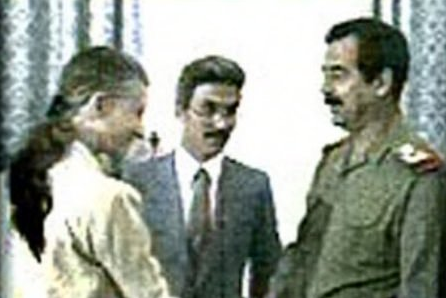aNewDomain — Like the nation of Oceania in George Orwell’s dystonian novel Nineteen Eighty-Four, the United States government creates its own enemies — often out of former friends.
 Not many Americans remember now, for example, that Saddam Hussein was a close ally on the U.S. throughout the 1980s; so cozy he was with us that in 1990 he spoke with US State Department diplomat April Glaspie about his amassing troops on the Kuwaiti border before his planned invasion. Glaspie, notoriously, gave tantamount approval.
Not many Americans remember now, for example, that Saddam Hussein was a close ally on the U.S. throughout the 1980s; so cozy he was with us that in 1990 he spoke with US State Department diplomat April Glaspie about his amassing troops on the Kuwaiti border before his planned invasion. Glaspie, notoriously, gave tantamount approval.
In a case of crossed signals out of a Marcel Pagnol novel, the wrong low-level diplomat signed off during the August doldrums, when official Washington is away on summer vacation.
And consider Libyan tyrant Col. Moammar Gaddafi. His relationship with DC seesawed wildly, from terrorist-supporting enemy whose daughter was blown up by Reagan’s bombs, to nuclear-disarming pal and force for pan-African stability, back to such an enemy that Obama hit him with a drone that pretty much killed him.
Now, as the U.S. goes after the radical Taliban-like group the Islamic State in Iraq and Syria (ISIS) in Iraq and now Syria, it’s worth pondering that this is yet another case of U.S. government agencies creating a monster that they or other U.S. government agencies will later determine must be killed.
Corporate media outlets imply that the US-created-ISIS story is nothing more than a silly conspiracy theory. As reported in The New York Times, here’s a typical example involving Iran’s supreme leader, Ayatollah Ali Khamenei, has often said that he believes ISIS was created by the United States as a way to regain a foothold in Iraq and to fight President Bashar al-Assad of Syria, an ally of Iran. ‘We have evidence, we know,’ he told an audience of clerics last week, without elaborating.”
Iran. Without elaborating.
Media experts call these “dog whistles,” signifiers meant to elicit an unpleasant subliminal reaction — in this case, that this is a story that shouldn’t be believed.
Except that it is true.
ISIS isn’t a joint Mossad-U.S. project, as some paranoid media outlets in the Muslim world claim. But the U.S. has certainly had an untoward hand in helping it to grow as quickly as it has.
As Vox Media recounts, the “most obvious culprit” for the rise of ISIS from nothing in 2012 to its current hold over half of Syria and half of Iraq is “Iraqi Prime Minister Nouri al-Maliki, a lame duck recently voted out by his own party [who], since 2006 has run an authoritarian, Shia government that systematically excluded Sunni Iraqis from power and favored the country’s majority Shia population.”
Despite his brutarian exclusionary approach to governance, the U.S. under Bush and Obama armed and funded Maliki, keeping him in power. “Maliki’s policies convinced a number of Iraqi Sunnis that the Iraqi government would never treat them equally, making ISIS and other Sunni militias seem like a comparatively attractive alternative. That’s a big part of how ISIS managed to gain so much power in Sunni Iraq in such a short period of time.”
The 2003 invasion of Iraq “accidentally sparked a sectarian civil war, and generally created the conditions for what was then Al Qaeda in Iraq to flourish. Without the American invasion, Al Qaeda in Iraq never would have been so strong, and ISIS never would have grown out of it.”
Finally there are America’s frenemies, the Arab Gulf States. “Saudi, Qatari, and Kuwaiti donors funneled a bunch of money towards Syrian rebel groups at the time ISIS most needed capital — and did it without much regard for who ended up getting the money.” The Gulf States would never have acted without the tacit consent of an Obama Administration willing to la-la-la-I-can’t-see-you.
One more thing. U.S. intelligence operatives delivered weapons and sent agents to train members of what the CIA told Congress was the Free Syrian Army in 2011 and 2012, but was actually the Al Nusra Front, the Al Qaeda affiliate in Syria that split into two factions, one of which became ISIS. “We had, in the early stages, information that radical groups had used the vacuum of the Arab Spring, and that some of the people the U.S. and their allies had trained to fight for ‘democracy’ in Libya and Syria had a jihadist agenda — already or later, [when they] joined al Nusra or the Islamic State,” a senior Arab intelligence official admitted to The Washington Post. When he and his colleagues tried to set the Americans straight, they were told no one at the White House wanted to hear it, and to shut up.
But wait, there’s more.
The U.S. dumped thousands of tons of weapons and ordnance into Iraq, handing it over to Maliki’s poorly-trained (by the U.S.) Iraqi Army. (Yes, everyone knew the Iraqi Army sucked.) When ISIS attacked, they ran away and the stockpile of U.S. munitions fell into the hands of ISIS, which is now using it to kill U.S.-backed Iraqi troops.
Aside from lives and credibility, the U.S. is paying a big price for the ISIS monster it helped create. Obama’s war against ISIS began barely four months ago, yet the Pentagon has already blown through $1.1 billion on it. Ex-Defense Secretary Leon Panetta says the conflict could go three decades. “We’re looking at kind of a 30-year war.”
Well, isn’t that swell.
The takeaway? We could have avoided this whole mess by staying out of Syria in the first place.
Image of US diplomat April Glaspie with Iraq dictator Saddam Hussein and translator in 1990: Wikimedia Commons
 For aNewDomain, I’m Ted Rall.
For aNewDomain, I’m Ted Rall.
Based in New York, Ted Rall is a syndicated columnist, political cartoonist and war correspondent — and senior commentator here at aNewDomain. A Pulitzer Prize finalist, Ted has recently published his latest BOOK , After We Kill You, We Will Welcome You Back As Honored Guests: Unembedded in Afghanistan, which is available now. Follow Ted @tedrall and via his page on Google +
, After We Kill You, We Will Welcome You Back As Honored Guests: Unembedded in Afghanistan, which is available now. Follow Ted @tedrall and via his page on Google +













